A Remote Assessment of Anxiety on Young People: Towards Their Views and Their Different Pet Interaction
Abstract
:1. Introduction
1.1. The Mobile Technology and the Mental Health
1.2. The Psychological Impact of the Pet Presence in Stressful Situations in Young People
1.3. The Impact of the Pandemic on the Youth’s Psychology
Purpose of the Study
- Collect structured feedback and views from the participants also in prospective use.
2. Methods
2.1. Participants and Procedure
2.1.1. The Tool: The Structure
2.1.2. Submission and Participants
2.2. Measures
2.3. Statistics
3. Results
3.1. Submission and Response Speed Rate
3.2. Preliminary Test of Statistical Significance
3.3. Outcome from the Zung Test
3.4. Feedback from the Participants
- The dog is recognized as having the added value of stimulating physical activity during the lockdown. In fact, in Italy, the dog represented a passport to go out for a walk during the most important restrictions.
- The dogs and the cats are recognized as comparable contributions to wellbeing.
- The questionnaire was found to be very useful.
4. Discussion
Limitations
5. Conclusions
Three Important Reccomandations Emerge
Author Contributions
Funding
Institutional Review Board Statement
Informed Consent Statement
Data Availability Statement
Conflicts of Interest
References
- World Health Organization. WHO Coronavirus (COVID-19) Dashboard. 2021. Available online: https://covid19.who.int/ (accessed on 18 August 2021).
- Duong, M.T.; Karlawish, J. Caregiving at a Physical Distance: Initial Thoughts for COVID-19 and Beyond. J. Am. Geriatr. Soc. 2020, 68, 1170–1172. [Google Scholar] [CrossRef] [Green Version]
- Zubatsky, M.; Berg-Weger, M.; Morley, J. Using Telehealth Groups to Combat Loneliness in Older Adults through COVID-19. J. Am. Geriatr. Soc. 2020, 68, 1678–1679. [Google Scholar] [CrossRef] [PubMed]
- Gabbiadini, A.; Baldissarri, C.; Durante, F.; Valtorta, R.R.; De Rosa, M.; Gallucci, M. Together Apart: The Mitigating Role of Digital Communication Technologies on Negative Affect During the COVID-19 Outbreak in Italy. Front. Psychol. 2020, 11, 554678. [Google Scholar] [CrossRef] [PubMed]
- Shah, S.G.S.; Nogueras, D.; Van Woerden, H.C.; Kiparoglou, V. The COVID-19 Pandemic—A pandemic of lockdown loneliness and the role of digital technology: A viewpoint. J. Med. Internet Res. 2020, 22, e22287. [Google Scholar] [CrossRef] [PubMed]
- Bashshur, R.; Doarn, C.R.; Frenk, J.M.; Kvedar, J.C.; Woolliscroft, J.O. Telemedicine and the COVID-19 Pandemic, Lessons for the Future. Telemed. e-Health 2020, 26, 571–573. [Google Scholar] [CrossRef] [Green Version]
- Braithwaite, I.; Callender, T.; Bullock, M.; Aldridge, R.W. Automated and partly automated contact tracing: A systematic review to inform the control of COVID-19. Lancet Digit. Health 2020, 2, e607–e621. [Google Scholar] [CrossRef]
- Kondylakis, H.; Katehakis, D.G.; Kouroubali, A.; Logothetidis, F.; Triantafyllidis, A.; Kalamaras, I.; Votis, K.; Tzovaras, D. COVID-19 Mobile Apps: A Systematic Review of the Literature. J. Med. Internet Res. 2020, 22, e23170. [Google Scholar] [CrossRef]
- Bergin, A.D.; Vallejos, E.P.; Davies, E.B.; Daley, D.; Ford, T.; Harold, G.; Hetrick, S.; Kidner, M.; Long, Y.; Merry, S.; et al. Preventive digital mental health interventions for children and young people: A review of the design and reporting of research. npj Digit Med. 2020, 3, 133. [Google Scholar] [CrossRef]
- Giansanti, D. Towards the evolution of the mHealth in mental health with youth: The cyber-space used in psychological rehabilitation is becoming wearable into a pocket. mHealth 2020, 6, 18. [Google Scholar] [CrossRef]
- Zung Test for Anxiety. Available online: https://psychology-tools.com/test/zung-anxiety-scale (accessed on 3 June 2022).
- Zung Test for Depression. Available online: https://psychology-tools.com/test/zung-depression-scale (accessed on 3 June 2022).
- Google Forms. Available online: https://www.google.com/intl/en-GB/forms/about/ (accessed on 3 June 2022).
- Microsoft Forms. Available online: https://www.microsoft.com/en-us/microsoft-365/online-surveys-polls-quizzes (accessed on 3 June 2022).
- Survey Monkey. Available online: https://www.surveymonkey.com/welcome/sem/?program=7013A000000mweBQAQ&utm_bu=CR&utm_campaign=71700000065817646&utm_adgroup=58700005812079224&utm_content=43700053053374146&utm_medium=cpc&utm_source=adwords&utm_term=p53053374146&utm_kxconfid=s4bvpi0ju&language=&test=&gclid=Cj0KCQiAjJOQBhCkARIsAEKMtO3TeOpV6XLNRvTjSvAvnYxCIhMGeq2pdXQxGvlIfJSmlojqoJdEUUwaAkiLEALw_wcB&gclsrc=aw.ds (accessed on 3 June 2022).
- Giansanti, D.; Maccioni, G. Health in the palm of your hand-part 1: The risks from smartphone abuse and the role of telemedicine and e-Health. Mhealth 2021, 7, 49. [Google Scholar] [CrossRef]
- Kwon, M.; Kim, D.J.; Cho, H.; Yang, S. The smartphone addiction scale: Development and validation of a short version for adolescents. PLoS ONE 2013, 8, e83558. [Google Scholar] [CrossRef] [PubMed] [Green Version]
- Giansanti, D.; Maccioni, G.; Simeoni, R. The mobile-born and the COVID-19 pandemic: Opportunities, problems and the role of the telemedicine and e-health. J. Public Health Emerg. 2021, 5, 2. [Google Scholar] [CrossRef]
- Kılınçel, Ş.; Kılınçel, O.; Muratdağı, G.; Aydın, A.; Usta, M.B. Factors affecting the anxiety levels of adolescents in home-quarantine during COVID-19 pandemic in Turkey. Asia Pac. Psychiatry 2021, 13, e12406. [Google Scholar] [CrossRef] [PubMed]
- Young, C.; Horton, J. Canine and Equine Therapy for Mental Health: A Review of Clinical Effectiveness; Canadian Agency for Drugs and Technologies in Health: Ottawa, ON, Canada, 2019. [Google Scholar]
- Jones, M.G.; Rice, S.M.; Cotton, S.M. Incorporating animal-assisted therapy in mental health treatments for adolescents: A systematic review of canine assisted psychotherapy. PLoS ONE 2019, 14, e0210761. [Google Scholar] [CrossRef] [PubMed]
- Wood, E.; Ohlsen, S.; Thompson, J.; Hulin, J.; Knowles, L. The feasibility of brief dog-assisted therapy on university students stress levels: The PAwS study. J. Ment. Health 2018, 27, 263–268. [Google Scholar] [CrossRef] [Green Version]
- Grajfoner, D.; Harte, E.; Potter, L.M.; McGuigan, N. The Effect of Dog-Assisted Intervention on Student Well-Being, Mood, and Anxiety. Int. J. Environ. Res. Public Health 2017, 14, 483. [Google Scholar] [CrossRef] [Green Version]
- Young, J.S. Pet therapy: Dogs de-stress students. J. Christ. Nurs. 2012, 29, 217–221. [Google Scholar] [CrossRef]
- Cherniack, E.P.; Cherniack, A.R. The Benefit of Pets and Animal-Assisted Therapy to the Health of Older Individuals. Curr. Gerontol. Geriatr. Res. 2014, 2014, 623203. [Google Scholar] [CrossRef] [Green Version]
- Giansanti, D.; Maccioni, G. The mHealth in the canine assisted therapy: The proposal of a conceptual model for the wearable monitoring. mHealth 2019, 5, 51. [Google Scholar] [CrossRef]
- Giansanti, D.; Maccioni, G. The mHealth in the canine assisted therapy: The design and application of a kit for the wearable monitoring during a walking session. Mhealth 2020, 6, 16. [Google Scholar] [CrossRef]
- Pubmed Search. Available online: https://pubmed.ncbi.nlm.nih.gov/?term=%28animal+assisted+therapy%5BTitle%2FAbstract%5D%29+AND+%28%28anxiety%5BTitle%2FAbstract%5D%29+OR+%28depression%5BTitle%2FAbstract%5D%29+OR+%28mental+health%5BTitle%2FAbstract%5D%29+OR+%28psychological+disorder%5BTitle%2FAbstract%5D%29%29&filter=pubt.review&sort=pubdate&size=100 (accessed on 3 June 2022).
- Peluso, S.; De Rosa, A.; De Lucia, N.; Antenora, A.; Illario, M.; Esposito, M.; De Michele, G. Animal-Assisted Therapy in Elderly Patients: Evidence and Controversies in Dementia and Psychiatric Disorders and Future Perspectives in Other Neurological Diseases. J. Geriatr. Psychiatry Neurol. 2018, 31, 149–157. [Google Scholar] [CrossRef] [PubMed]
- Bert, F.; Gualano, M.R.; Camussi, E.; Pieve, G.; Voglino, G.; Siliquini, R. Animal assisted intervention: A systematic review of benefits and risks. Eur. J. Integr. Med. 2016, 8, 695–706. [Google Scholar] [CrossRef] [PubMed] [Green Version]
- Needell, N.J.; Mehta-Naik, N. Is Pet Ownership Helpful in Reducing the Risk and Severity of Geriatric Depression? Geriatrics 2016, 1, 24. [Google Scholar] [CrossRef]
- Villafaina-Domínguez, B.; Collado-Mateo, D.; Merellano-Navarro, E.; Villafaina, S. Effects of Dog-Based Animal-Assisted Interventions in Prison Population: A Systematic Review. Animals 2020, 10, 2129. [Google Scholar] [CrossRef]
- Wu, Z.; Liu, Z.; Zou, Z.; Wang, F.; Zhu, M.; Zhang, W.; Tao, H.; Ross, B.; Long, Y. Changes of psychotic-like experiences and their association with anxiety/depression among young adolescents before COVID-19 and after the lockdown in China. Schizophr. Res. 2021, 237, 40–46. [Google Scholar] [CrossRef] [PubMed]
- Dratva, J.; Zysset, A.; Schlatter, N.; von Wyl, A.; Huber, M.; Volken, T. Swiss University Students’ Risk Perception and General Anxiety during the COVID-19 Pandemic. Int. J. Environ. Res. Public Health 2020, 17, 7433. [Google Scholar] [CrossRef]
- Lima, M.; Mateus, T.L.; Silva, K. With or without You: Beneficial and Detrimental Associations between Companion Dogs and Human Psychological Adjustment During a COVID-19 Lockdown Phase. Anthrozoös 2022. [Google Scholar] [CrossRef]
- Wells, D.L.; Clements, M.A.; Elliott, L.J.; Meehan, E.S.; Montgomery, C.J.; Williams, G.A. Quality of the Human–Animal Bond and Mental Wellbeing During a COVID-19 Lockdown. Anthrozoös 2022. [Google Scholar] [CrossRef]
- Shoesmith, E.; Shahab, L.; Kale, D.; Mills, D.S.; Reeve, C.; Toner, P.; Santos de Assis, L.; Ratschen, E. The Influence of Human–Animal Interactions on Mental and Physical Health during the First COVID-19 Lockdown Phase in the U.K.: A Qualitative Exploration. Int. J. Environ. Res. Public Health 2021, 18, 976. [Google Scholar] [CrossRef]
- Grajfoner, D.; Ke, G.N.; Wong, R.M.M. The Effect of Pets on Human Mental Health and Wellbeing during COVID-19 Lockdown in Malaysia. Animals 2021, 11, 2689. [Google Scholar] [CrossRef]
- Hoffman, C.L. The Experience of Teleworking with Dogs and Cats in the United States during COVID-19. Animals 2021, 11, 268. [Google Scholar] [CrossRef] [PubMed]
- Fine, A.H. The Year That Has Passed Us By: Animals in Our Life of COVID-19. Animals 2021, 11, 395. [Google Scholar] [CrossRef] [PubMed]
- Ikeuchi, T.; Taniguchi, Y.; Abe, T.; Seino, S.; Shimada, C.; Kitamura, A.; Shinkai, S. Association between Experience of Pet Ownership and Psychological Health among Socially Isolated and Non-Isolated Older Adults. Animals 2021, 11, 595. [Google Scholar] [CrossRef] [PubMed]
- Mueller, M.K.; Richer, A.M.; Callina, K.S.; Charmaraman, L. Companion Animal Relationships and Adolescent Loneliness during COVID-19. Animals 2021, 11, 885. [Google Scholar] [CrossRef]
- McDonald, S.E.; O’Connor, K.E.; Matijczak, A.; Tomlinson, C.A.; Applebaum, J.W.; Murphy, J.L.; Zsembik, B.A. Attachment to Pets Moderates Transitions in Latent Patterns of Mental Health Following the Onset of the COVID-19 Pandemic: Results of a Survey of U.S. Adults. Animals 2021, 11, 895. [Google Scholar] [CrossRef]
- Kogan, L.R.; Currin-McCulloch, J.; Bussolari, C.; Packman, W.; Erdman, P. The Psychosocial Influence of Companion Animals on Positive and Negative Affect during the COVID-19 Pandemic. Animals 2021, 11, 2084. [Google Scholar] [CrossRef]
- Hawkins, R.D.; Brodie, Z.P. The role of human-pet attachment on people’s mental health and wellbeing over time during COVID-19 lockdown. In Proceedings of the NRS Mental Health 2020 Annual Scientific Meeting, online, 4 November 2020. [Google Scholar]
- Bowen, J.; García, E.; Darder, P.; Argüelles, J.; Fatjó, J. The effects of the Spanish COVID-19 lockdown on people, their pets, and the human-animal bond. J. Vet. Behav. 2020, 40, 75–91. [Google Scholar] [CrossRef] [PubMed]
- Phillipou, A.; Tan, E.J.; Toh, W.L.; Van Rheenen, T.E.; Meyer, D.; Neill, E.; Sumner, P.J.; Rossell, S.L. Pet ownership and mental health during COVID-19 lockdown. Aust. Vet. J. 2021, 99, 423–426. [Google Scholar] [CrossRef]
- Ratschen, E.; Shoesmith, E.; Shahab, L.; Silva, K.; Kale, D.; Toner, P.; Reeve, C.; Mills, D.S. Human-animal relationships and interactions during the Covid-19 lockdown phase in the UK: Investigating links with mental health and loneliness. PLoS ONE 2020, 15, e0239397. [Google Scholar] [CrossRef]
- Dunstan, D.A.; Scott, N. Norms for Zung’s Self-rating Anxiety Scale. BMC Psychiatry 2020, 20, 90. [Google Scholar] [CrossRef] [Green Version]
- Zung, W.W. The differentiation of anxiety and depressive disorders: A biometric approach. Psychosomatics 1971, 12, 380–384. [Google Scholar] [CrossRef]
- Zung, W.W. A rating instrument for anxiety disorders. Psychosomatics 1971, 12, 371–379. [Google Scholar] [CrossRef]
- Dodge, Y. Kolmogorov–Smirnov Test. In The Concise Encyclopedia of Statistics; Springer: New York, NY, USA, 2008. [Google Scholar]
- Salomon, J.A.; Reinhart, A.; Bilinski, A.; Chua, E.J.; La Motte-Kerr, W.; Rönn, M.M.; Reitsma, M.B.; Morris., K.A.; LaRocca., S.; Farag., T.H.; et al. The US COVID-19 Trends and Impact Survey: Continuous real-time measurement of COVID-19 symptoms, risks, protective behaviors, testing, and vaccination. Proc. Natl. Acad. Sci. USA 2021, 118, e2111454118. [Google Scholar] [CrossRef] [PubMed]
- Choi, H.; Jeong, G. Characteristics of the Measurement Tools for Assessing Health Information-Seeking Behaviors in Nationally Representative Surveys: Systematic Review. J. Med. Internet Res. 2021, 23, e27539. [Google Scholar] [CrossRef] [PubMed]
- Orgilés, M.; Espada, J.P.; Delvecchio, E.; Francisco, R.; Mazzeschi, C.; Pedro, M.; Morales, A. Anxiety and Depressive Symptoms in Children and Adolescents during COVID-19 Pandemic: A Transcultural Approach. Psicothema 2021, 33, 125–130. [Google Scholar] [CrossRef] [PubMed]
- Wang, C.; Zhao, H. The Impact of COVID-19 on Anxiety in Chinese University Students. Front. Psychol. 2020, 11, 1168. [Google Scholar] [CrossRef]
- Qiu, J.; Shen, B.; Zhao, M.; Wang, Z.; Xie, B.; Xu, Y. A nationwide survey of psychological distress among Chinese people in the COVID-19 epidemic: Implications and policy recommendations. Gen. Psychiatry 2020, 33, e100213. [Google Scholar] [CrossRef] [Green Version]
- Boldt, K.; Coenen, M.; Movsisyan, A.; Voss, S.; Rehfuess, E.; Kunzler, A.M.; Lieb, K.; Jung-Sievers, C. Interventions to ameliorate the psychosocial effects of the COVID-19 pandemic on children—A systematic review. Int. J. Environ. Res. Public Health 2021, 18, 2361. [Google Scholar] [CrossRef]
- Giansanti, D.; Veltro, G. The Digital Divide in the Era of COVID-19: An Investigation into an Important Obstacle to the Access to the mHealth by the Citizen. Healthcare 2021, 9, 371. [Google Scholar] [CrossRef]
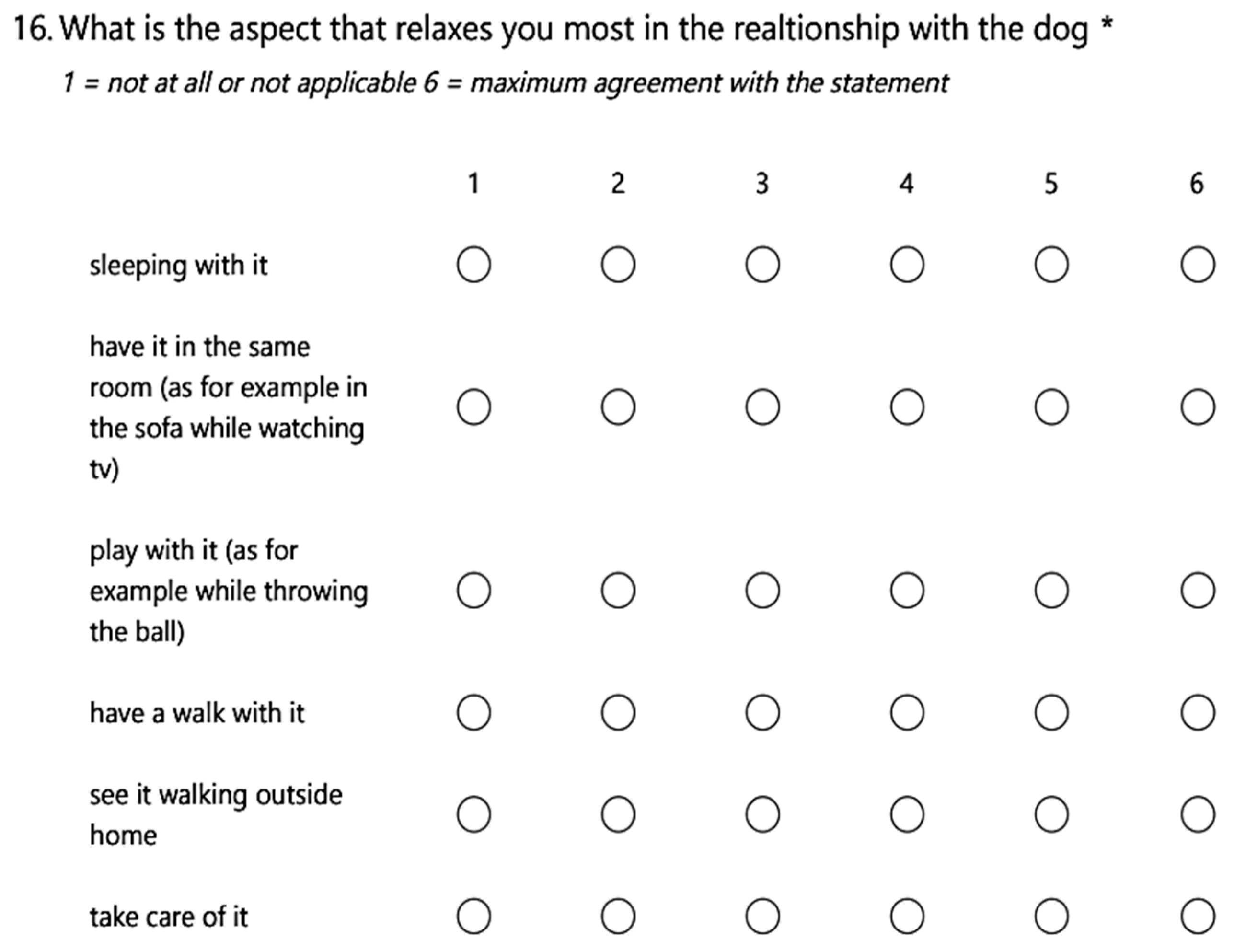
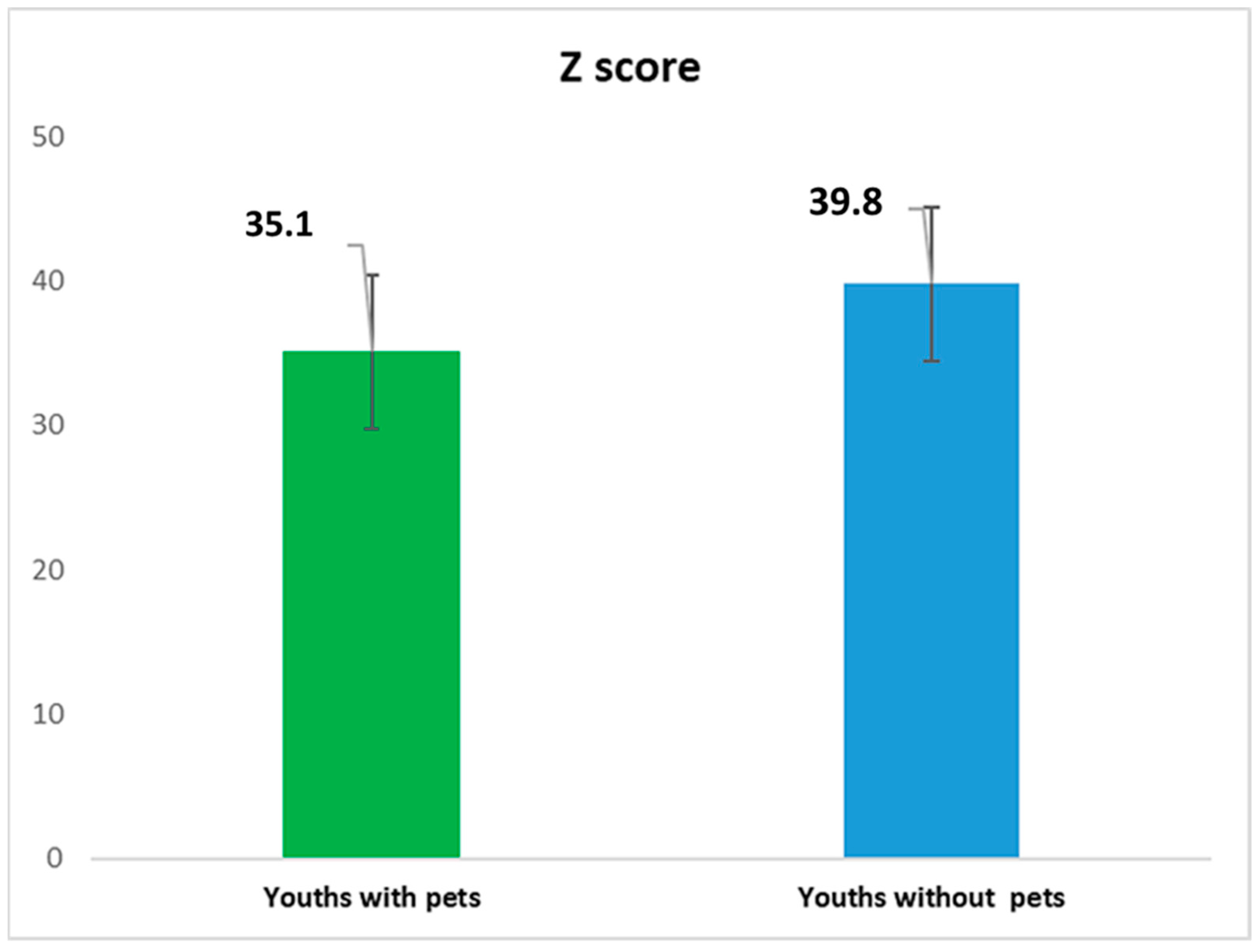
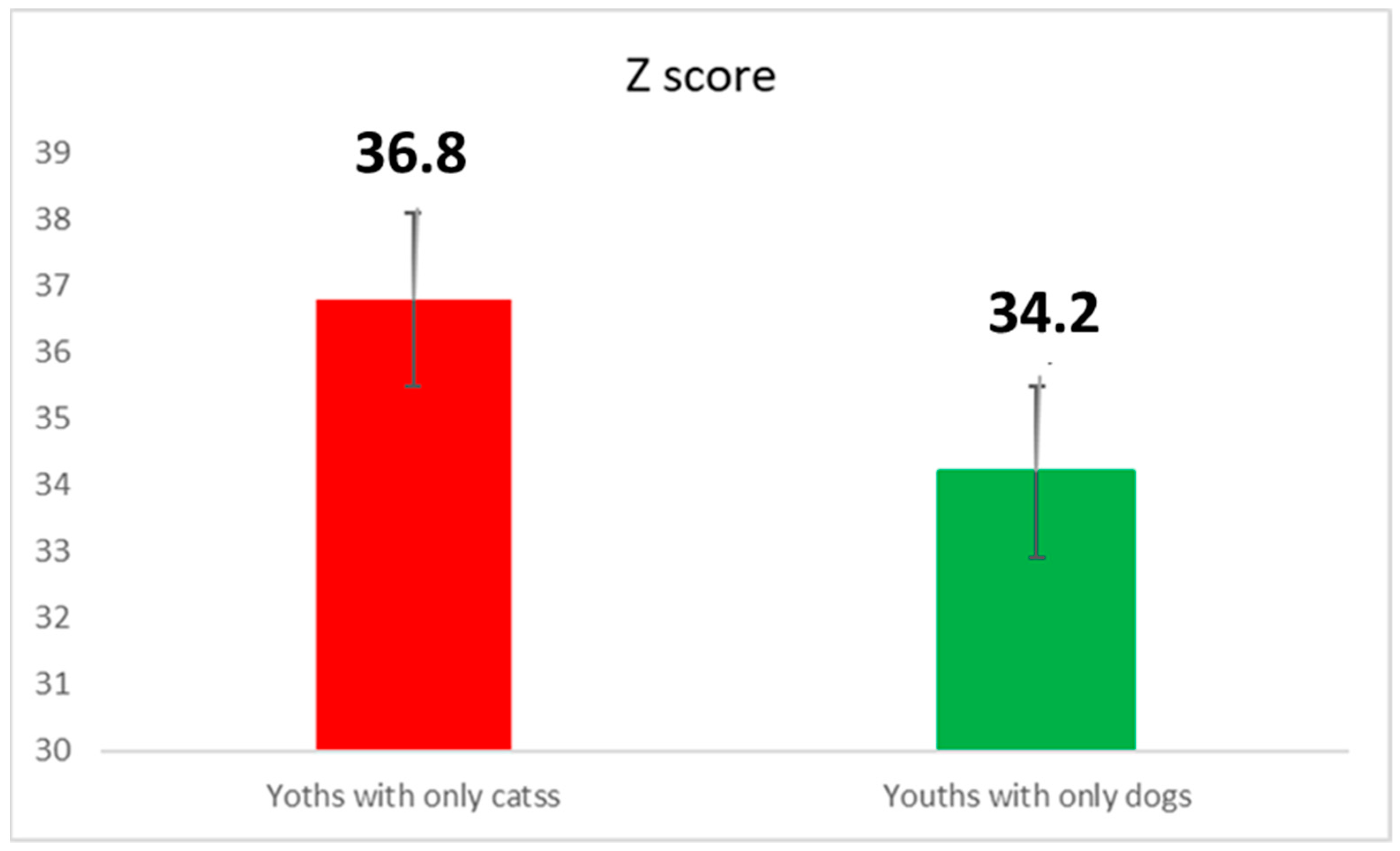
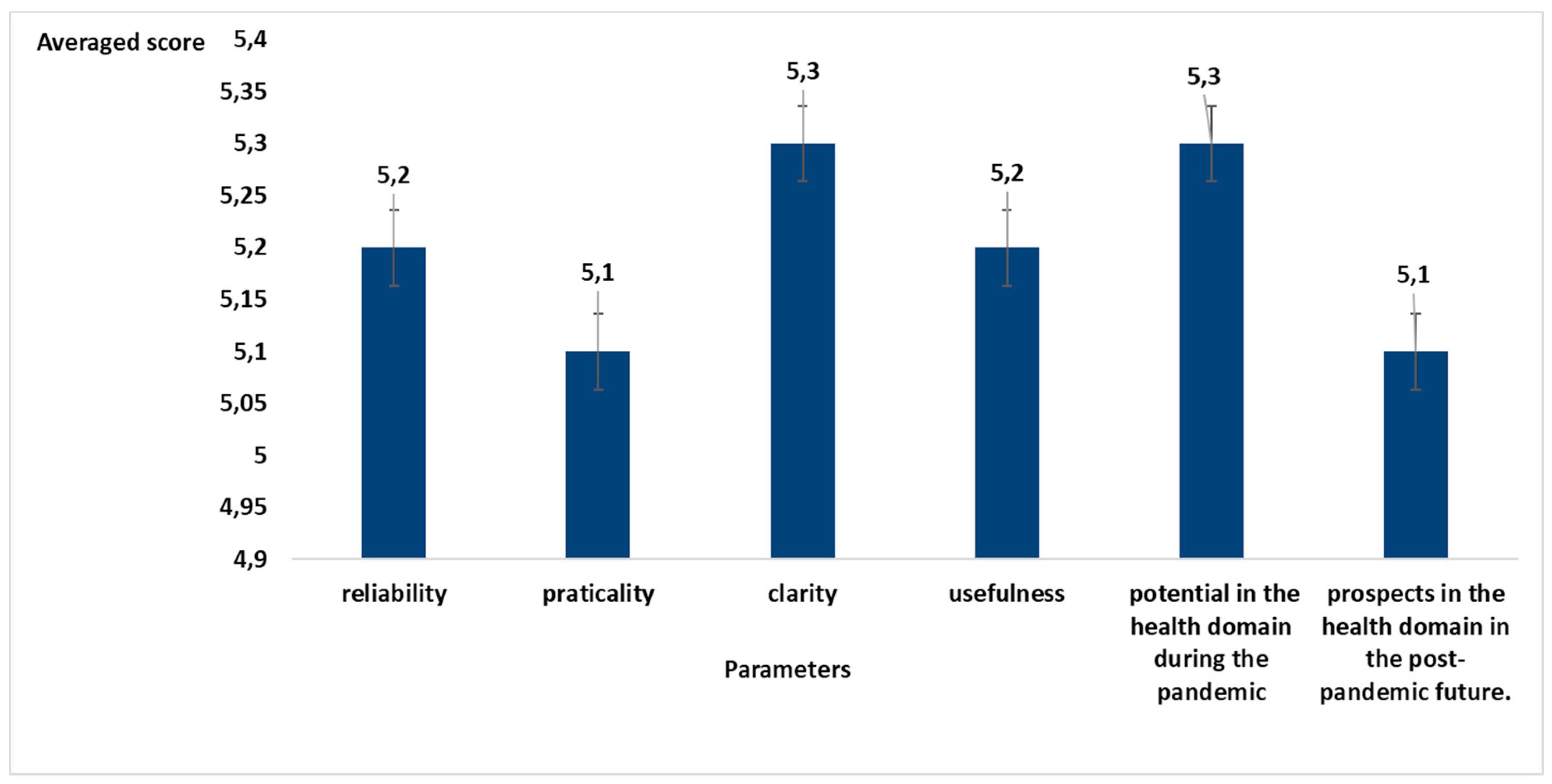
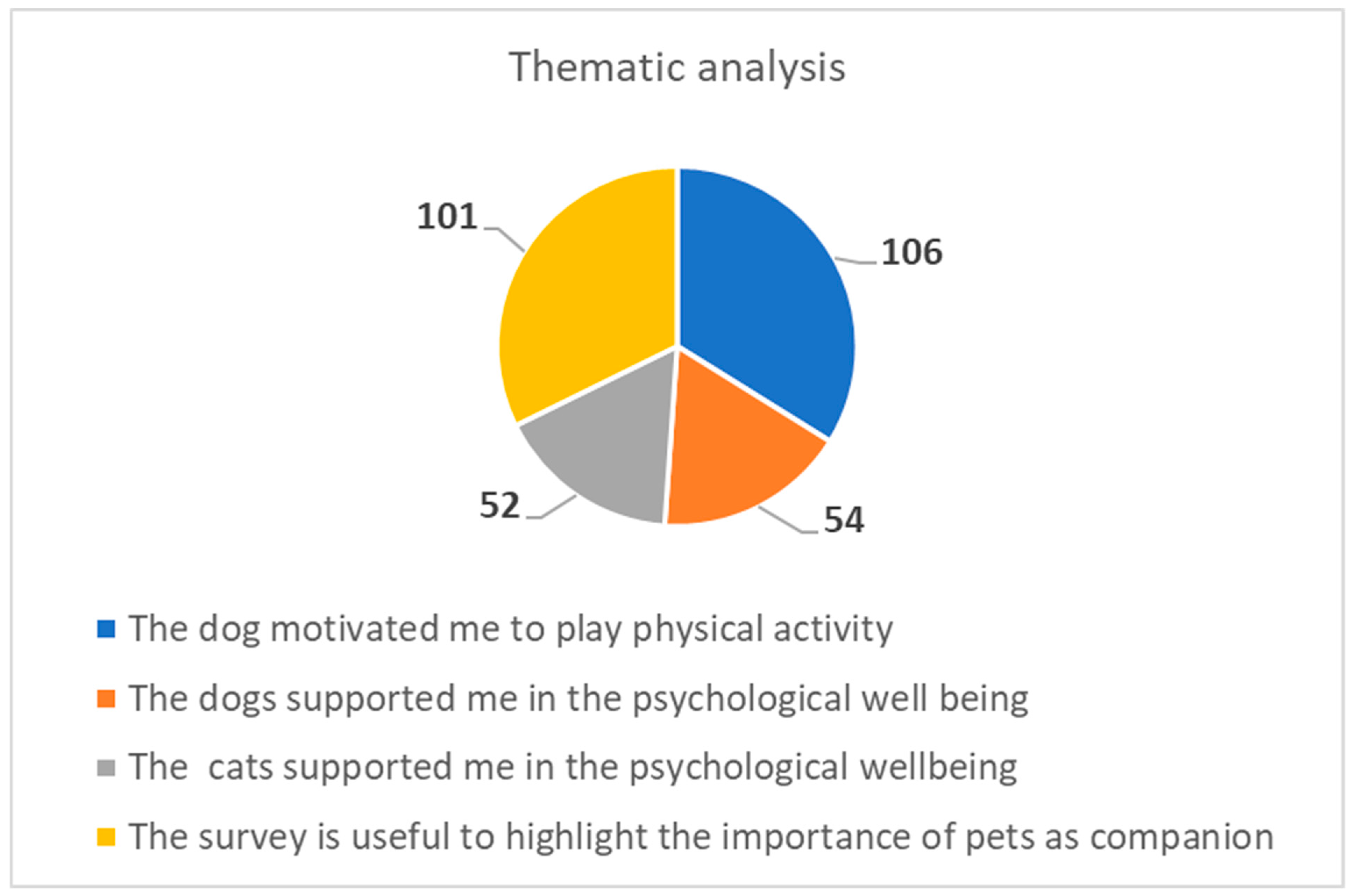
| Young Participants | Students | Psychological Problems | N | Pet Owned | |
|---|---|---|---|---|---|
| Pet owners Age between 14 and 29 years; 50.7% males (mean age 21.7 years; maximum age 29 years); 49.3% females (mean age 21.4 years; maximum age 29 years) | All | No | 370 | One or more dogs | 179 |
| One or more cats | 124 | ||||
| Cats and dogs | 67 | ||||
| Not pet owners Age between 14 and 29 years; 50.5% males (mean age 21.5 years; maximum age 29 years); 49.5% females (mean age 21.6 years; maximum age 29 years) | All | No | 282 | None | |
| Comment |
|---|
| I do not appreciate the administration of psychological tests remotely, I think that this type of evaluation must always done in presence even in periods in which social distancing is in force. |
| I think that the Italian government could use these methods for targeted assessment campaigns on categories of subjects exposed to psychological risks, but I think that familiarity with smartphones and tablets should be increased to broaden the audience. |
| The use of psychology in Italy is still very limited. There are countries where the psychologist is requested with the same frequency as the family doctor. Surely reaching the citizen with these tools could help to bring out hidden problems. |
| I really appreciated this survey both for its aspects related to anxiety and because it tried to highlight the importance of pets that in my opinion are our angelsand are helping us a lot in this moment of emergency |
| Pets are a great help that is often underestimated and little appreciated as psychological support. All the initiatives that support the role and importance of pets are well |
| I took the test. I did not know it and I found it very useful. I don’t have a dog or a cat but those who have one tell me that in this moment of emergency they feel particularly helped by the proximity of this animal. I’m thinking of getting one and the survey has given me a boost in this direction. |
| I am very convinced that pets reduce anxiety and depression. These measures are useful to politicians because they realize that they need to help with economic incentives those who have pets and those who cannot afford them, such as the elderly with a low pension. |
| I am allergic to cat and dog hair and I think all this hype around the usefulness of pets is wrong. We should try to be closer between us humans so both anxiety and stress decreases. |
| It seems to me that the proposed system, if I have understood well, allows for telemedicine. Always, if I understand correctly, the dog in this case is the therapy against anxiety, a bit like insulin against high blood sugar (which I have), the psychological test measures anxiety like the blood glucose machine is used for measure sugars []. |
| I really liked the survey that, I think, you developed in a hurry to face the emergency. In the future, however, I suggest that you include other parameters relating to the home or family or other disturbing factors in the test |
Publisher’s Note: MDPI stays neutral with regard to jurisdictional claims in published maps and institutional affiliations. |
© 2022 by the authors. Licensee MDPI, Basel, Switzerland. This article is an open access article distributed under the terms and conditions of the Creative Commons Attribution (CC BY) license (https://creativecommons.org/licenses/by/4.0/).
Share and Cite
Giansanti, D.; Siotto, M.; Maccioni, G.; Aprile, I. A Remote Assessment of Anxiety on Young People: Towards Their Views and Their Different Pet Interaction. Healthcare 2022, 10, 1242. https://doi.org/10.3390/healthcare10071242
Giansanti D, Siotto M, Maccioni G, Aprile I. A Remote Assessment of Anxiety on Young People: Towards Their Views and Their Different Pet Interaction. Healthcare. 2022; 10(7):1242. https://doi.org/10.3390/healthcare10071242
Chicago/Turabian StyleGiansanti, Daniele, Mariacristina Siotto, Giovanni Maccioni, and Irene Aprile. 2022. "A Remote Assessment of Anxiety on Young People: Towards Their Views and Their Different Pet Interaction" Healthcare 10, no. 7: 1242. https://doi.org/10.3390/healthcare10071242







